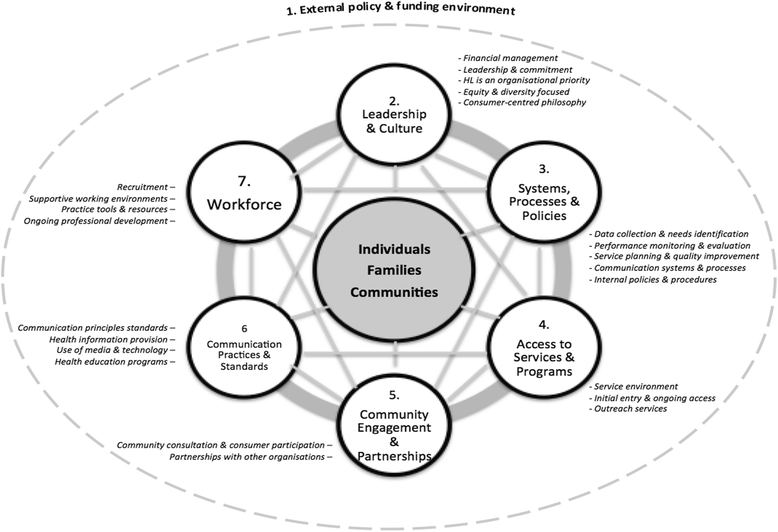Development of the organisational health literacy responsiveness (Org-HLR) framework in collaboration with health and social services professionals
- PMID: 28764699
- PMCID: PMC5539902
- DOI: 10.1186/s12913-017-2465-z
Development of the organisational health literacy responsiveness (Org-HLR) framework in collaboration with health and social services professionals
Abstract
Background: The health literacy skills required by individuals to interact effectively with health services depends on the complexity of those services, and the demands they place on people. Public health and social service organisations have a responsibility to provide services and information in ways that promote equitable access and engagement, that are responsive to diverse needs and preferences, and support people to participate in decisions regarding their health and wellbeing. The aim of this study was to develop a conceptual framework describing the characteristics of health literacy responsive organisations.
Methods: Concept mapping (CM) workshops with six groups of professionals (total N = 42) from across health and social services sectors were undertaken. An online concept mapping consultation with 153 professionals was also conducted. In these CM activities, participants responded to the seeding statement "Thinking broadly from your experiences of working in the health system, what does an organisation need to have or do in order to enable communities and community members to fully engage with information and services to promote and maintain health and wellbeing". The CM data were analysed using multidimensional scaling and hierarchical cluster analyses to derive concept maps and cluster tree diagrams. Clusters from the CM processes were then integrated by identifying themes and subthemes across tree diagrams.
Results: Across the workshops, 373 statements were generated in response to the seeding statement. An additional 1206 statements were generated in the online consultation. 84 clusters were derived within the workshops and 20 from the online consultation. Seven domains of health literacy responsiveness were identified; i) External policy and funding environment; ii) Leadership and culture; iii) Systems, processes and policies; iv) Access to services and programs; v) Community engagement and partnerships; vi) Communication practices and standards; and vii) Workforce. Each domain included 1 to 5 sub-domains (24 sub-domains in total).
Conclusions: Using participatory research processes, a conceptual framework describing the characteristics, values, practices and capabilities of organisational health literacy responsiveness was derived. The framework may guide the planning and monitoring of health service and health system improvements, and has the potential to guide effective public health policy and health system reforms.
Keywords: Access; Concept mapping; Equity; Health literacy; Health literacy responsiveness; Health system improvement; Health systems; Health systems strengthening; Service improvements.
Conflict of interest statement
Ethics approval and consent to participate
This study was approved by the Deakin University Human Research Ethics Committee (Study ID: 2012–295). All participants provided informed consent to participate in this study.
Consent for publication
Not applicable.
Competing interests
The authors declare that they have no competing interests.
Publisher’s Note
Springer Nature remains neutral with regard to jurisdictional claims in published maps and institutional affiliations.
Figures



References
-
- Berkman ND, Sheridan SL, Donahue KE, Halpern DJ, Viera A, Crotty K, et al. Health literacy interventions and outcomes: an updated systematic review. Evidence Report/Technology Assessment Rockville, MD: Agency for Healthcare Research and Quality. 2011;199 - PubMed
MeSH terms
LinkOut - more resources
Full Text Sources
Other Literature Sources
Medical

